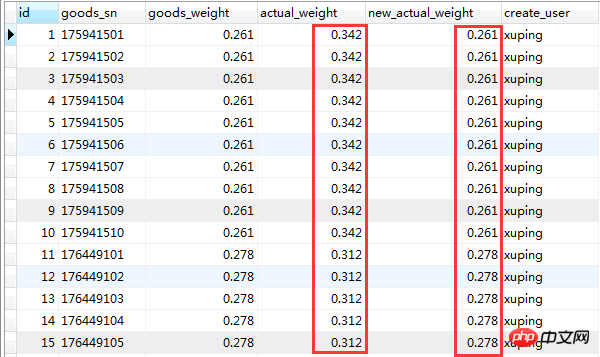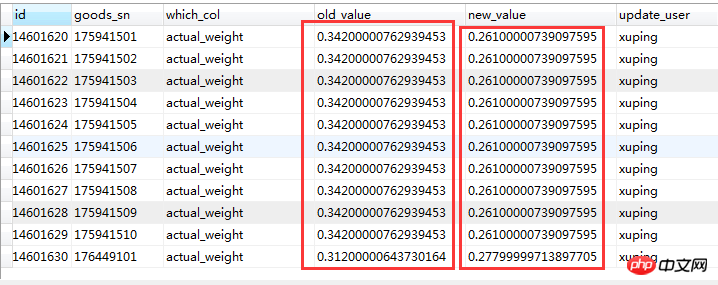 Database
Database
 Mysql Tutorial
Mysql Tutorial
 Solving some problems in converting floating point type to character type in MySQL
Solving some problems in converting floating point type to character type in MySQL
Solving some problems in converting floating point type to character type in MySQL
Type conversion is a requirement that we often encounter in daily development. Recently, we encountered a problem when converting floating point type into character type, so I will summarize and share it. The following article mainly introduces it to you. Friends in need can refer to the relevant information about the problems that may be encountered when converting floating point to character in MySQL.
Preface
This article mainly introduces you to a problem encountered when converting floating point type to character type in MySQL. Share It’s here for everyone’s reference and study. I won’t say much more, let’s take a look at the detailed introduction.
1 Problem description
Today I encountered a need to refresh data, which is to modify the weight of the product (field type is float), modified After the weight of the product, it needs to be recorded in the log table (field type is varchar). The table structure is as follows:
Temporarily refresh the data table:
CREATE TABLE `temp_170830` ( `id` int(10) unsigned NOT NULL AUTO_INCREMENT COMMENT '主键ID', `goods_sn` varchar(255) NOT NULL DEFAULT '' COMMENT '产品编码', `goods_weight` float(9,4) NOT NULL DEFAULT '0.0000' COMMENT '产品重量', `actual_weight` float(9,4) NOT NULL DEFAULT '0.0000' COMMENT '实际重量', `new_actual_weight` float(9,4) NOT NULL DEFAULT '0.0000' COMMENT '新的实际重量', `create_user` varchar(30) NOT NULL DEFAULT '' COMMENT '创建人', PRIMARY KEY (`id`), KEY `idx_goods_sn` (`goods_sn`) ) ENGINE=InnoDB AUTO_INCREMENT=8192 DEFAULT CHARSET=utf8 COMMENT='临时刷重量表';
Log table:
CREATE TABLE `log_weight` ( `id` int(10) unsigned NOT NULL AUTO_INCREMENT COMMENT '主键ID', `goods_sn` varchar(50) NOT NULL DEFAULT '' COMMENT '产品编码', `which_col` varchar(100) NOT NULL DEFAULT '' COMMENT '修改字段', `old_value` varchar(50) NOT NULL DEFAULT '0.00' COMMENT '更新前值', `new_value` varchar(50) NOT NULL DEFAULT '0.00' COMMENT '更新后值', `update_user` varchar(100) NOT NULL DEFAULT '' COMMENT '创建人', `update_time` datetime NOT NULL DEFAULT CURRENT_TIMESTAMP ON UPDATE CURRENT_TIMESTAMP, `wh_update_time` timestamp NOT NULL DEFAULT CURRENT_TIMESTAMP ON UPDATE CURRENT_TIMESTAMP COMMENT '记录修改时间', PRIMARY KEY (`id`), KEY `idx_goods_sn` (`goods_sn`), KEY `idx_update_user` (`update_user`), KEY `wh_update_time` (`wh_update_time`) ) ENGINE=InnoDB AUTO_INCREMENT=14601620 DEFAULT CHARSET=utf8 COMMENT='重量修改日志';
As shown in the table built above, I need to change the actual_weight of the temp_170830 table and new_actual_weight fields are flushed into the old_value and new_value fields of the log_weight table respectively. The SQL statement is as follows:
INSERT INTO log_weight(goods_sn, which_col, old_value, new_value, update_user) SELECT goods_sn,'actual_weight',actual_weight,new_actual_weight,create_user FROM temp_170830;
I thought I was done here. After all, I just inserted some log records. Later, for a simple verification, I found that something was wrong with the data, as shown in the figure below:
Temporary table data screenshot:

Screenshot of log table data:

By comparison, it can be found that the inserted log record data has many decimal places at the end for no reason. I don’t know where it comes from. Where did it come from? Then I thought about it, maybe the original floating point data cannot be divided, and when it was converted to varchar, the following ones were also brought out. I am not sure at the moment. I will confirm it later. Supplement, and then I temporarily found a way to convert varchar to concat, and adjusted it as follows:
##
INSERT INTO log_weight(goods_sn, which_col, old_value, new_value, update_user) SELECT goods_sn,'actual_weight',concat(actual_weight,''),concat(new_actual_weight,''),create_user FROM temp_170830;
The summary is as follows:
The above is the detailed content of Solving some problems in converting floating point type to character type in MySQL. For more information, please follow other related articles on the PHP Chinese website!

Hot AI Tools

Undresser.AI Undress
AI-powered app for creating realistic nude photos

AI Clothes Remover
Online AI tool for removing clothes from photos.

Undress AI Tool
Undress images for free

Clothoff.io
AI clothes remover

Video Face Swap
Swap faces in any video effortlessly with our completely free AI face swap tool!

Hot Article

Hot Tools

Notepad++7.3.1
Easy-to-use and free code editor

SublimeText3 Chinese version
Chinese version, very easy to use

Zend Studio 13.0.1
Powerful PHP integrated development environment

Dreamweaver CS6
Visual web development tools

SublimeText3 Mac version
God-level code editing software (SublimeText3)

Hot Topics
 1665
1665
 14
14
 1424
1424
 52
52
 1322
1322
 25
25
 1270
1270
 29
29
 1250
1250
 24
24
 Laravel Introduction Example
Apr 18, 2025 pm 12:45 PM
Laravel Introduction Example
Apr 18, 2025 pm 12:45 PM
Laravel is a PHP framework for easy building of web applications. It provides a range of powerful features including: Installation: Install the Laravel CLI globally with Composer and create applications in the project directory. Routing: Define the relationship between the URL and the handler in routes/web.php. View: Create a view in resources/views to render the application's interface. Database Integration: Provides out-of-the-box integration with databases such as MySQL and uses migration to create and modify tables. Model and Controller: The model represents the database entity and the controller processes HTTP requests.
 MySQL and phpMyAdmin: Core Features and Functions
Apr 22, 2025 am 12:12 AM
MySQL and phpMyAdmin: Core Features and Functions
Apr 22, 2025 am 12:12 AM
MySQL and phpMyAdmin are powerful database management tools. 1) MySQL is used to create databases and tables, and to execute DML and SQL queries. 2) phpMyAdmin provides an intuitive interface for database management, table structure management, data operations and user permission management.
 MySQL vs. Other Programming Languages: A Comparison
Apr 19, 2025 am 12:22 AM
MySQL vs. Other Programming Languages: A Comparison
Apr 19, 2025 am 12:22 AM
Compared with other programming languages, MySQL is mainly used to store and manage data, while other languages such as Python, Java, and C are used for logical processing and application development. MySQL is known for its high performance, scalability and cross-platform support, suitable for data management needs, while other languages have advantages in their respective fields such as data analytics, enterprise applications, and system programming.
 Solve database connection problem: a practical case of using minii/db library
Apr 18, 2025 am 07:09 AM
Solve database connection problem: a practical case of using minii/db library
Apr 18, 2025 am 07:09 AM
I encountered a tricky problem when developing a small application: the need to quickly integrate a lightweight database operation library. After trying multiple libraries, I found that they either have too much functionality or are not very compatible. Eventually, I found minii/db, a simplified version based on Yii2 that solved my problem perfectly.
 Laravel framework installation method
Apr 18, 2025 pm 12:54 PM
Laravel framework installation method
Apr 18, 2025 pm 12:54 PM
Article summary: This article provides detailed step-by-step instructions to guide readers on how to easily install the Laravel framework. Laravel is a powerful PHP framework that speeds up the development process of web applications. This tutorial covers the installation process from system requirements to configuring databases and setting up routing. By following these steps, readers can quickly and efficiently lay a solid foundation for their Laravel project.
 Solve MySQL mode problem: The experience of using the TheliaMySQLModesChecker module
Apr 18, 2025 am 08:42 AM
Solve MySQL mode problem: The experience of using the TheliaMySQLModesChecker module
Apr 18, 2025 am 08:42 AM
When developing an e-commerce website using Thelia, I encountered a tricky problem: MySQL mode is not set properly, causing some features to not function properly. After some exploration, I found a module called TheliaMySQLModesChecker, which is able to automatically fix the MySQL pattern required by Thelia, completely solving my troubles.
 MySQL: Structured Data and Relational Databases
Apr 18, 2025 am 12:22 AM
MySQL: Structured Data and Relational Databases
Apr 18, 2025 am 12:22 AM
MySQL efficiently manages structured data through table structure and SQL query, and implements inter-table relationships through foreign keys. 1. Define the data format and type when creating a table. 2. Use foreign keys to establish relationships between tables. 3. Improve performance through indexing and query optimization. 4. Regularly backup and monitor databases to ensure data security and performance optimization.
 MySQL: Key Features and Capabilities Explained
Apr 18, 2025 am 12:17 AM
MySQL: Key Features and Capabilities Explained
Apr 18, 2025 am 12:17 AM
MySQL is an open source relational database management system that is widely used in Web development. Its key features include: 1. Supports multiple storage engines, such as InnoDB and MyISAM, suitable for different scenarios; 2. Provides master-slave replication functions to facilitate load balancing and data backup; 3. Improve query efficiency through query optimization and index use.



